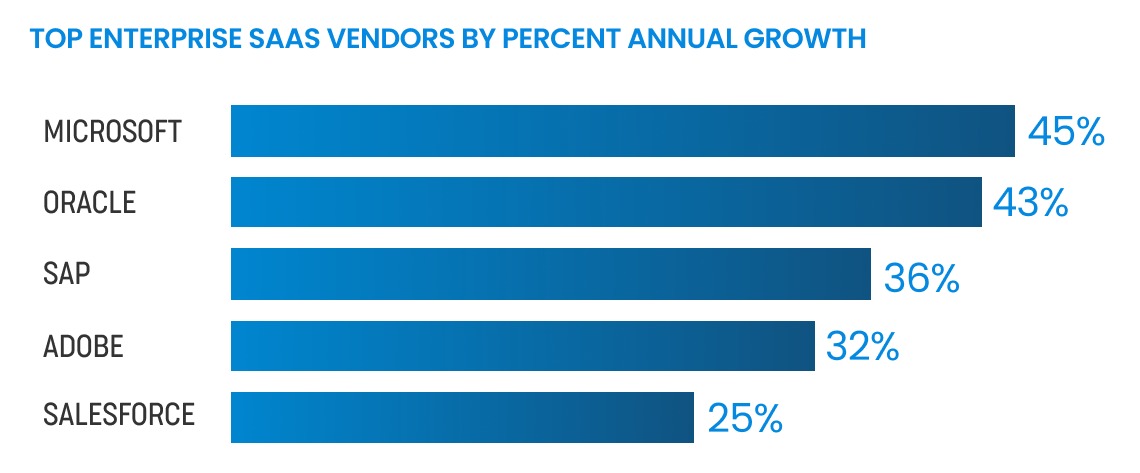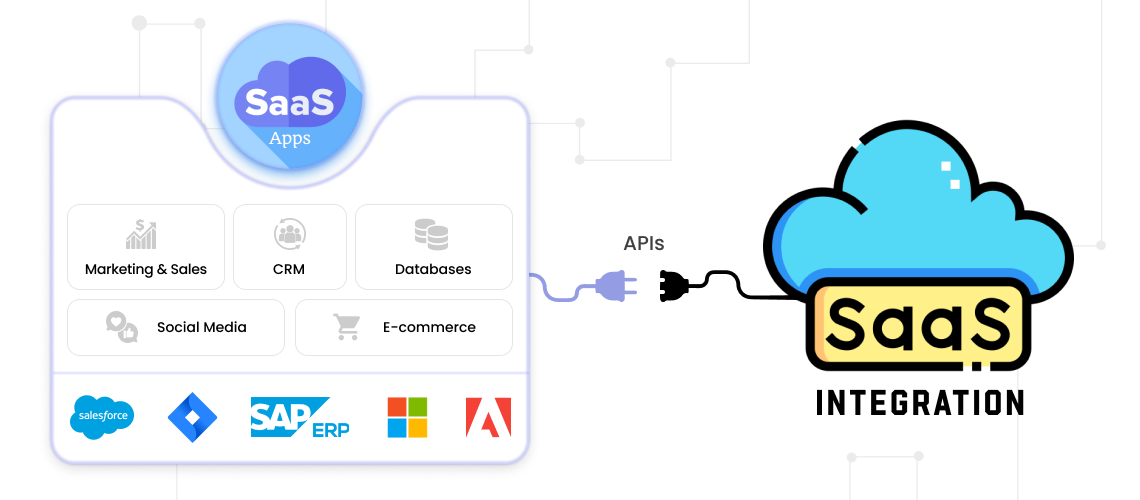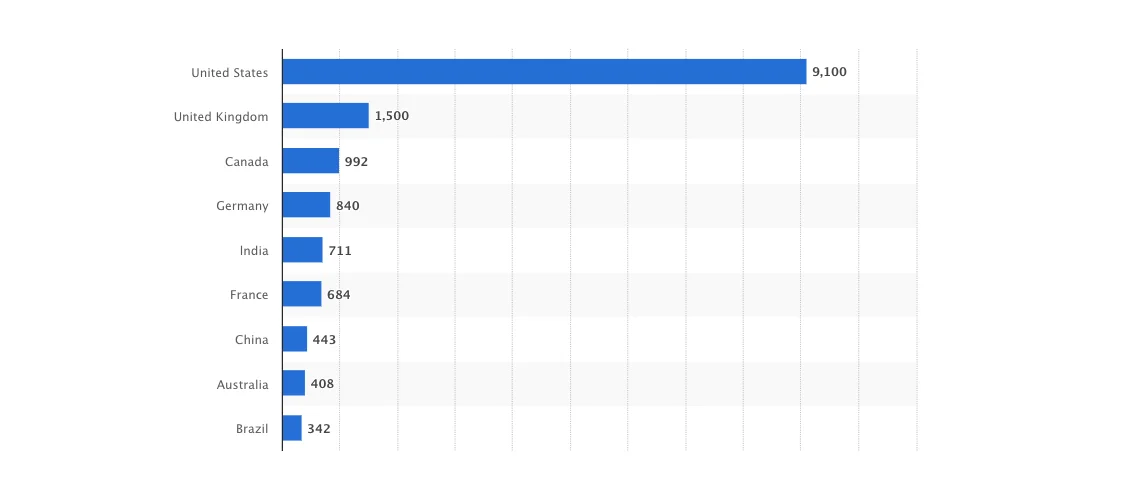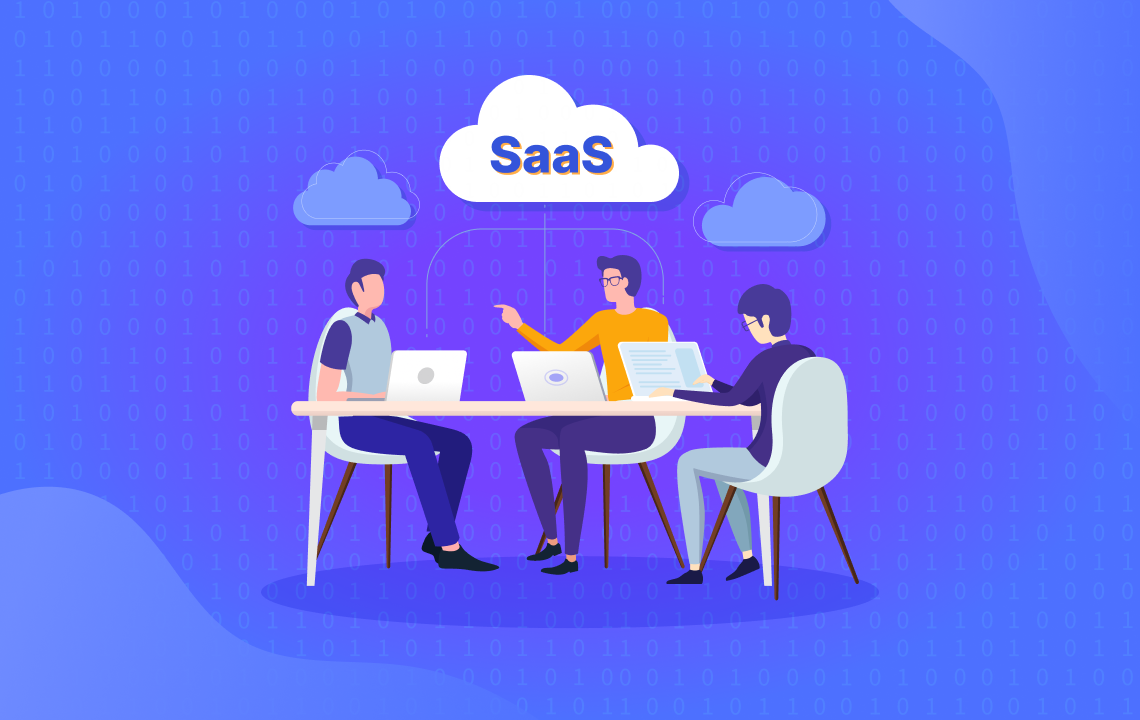B2B SaaS Integration: Why Need It and How Can Your Business Achieve It?
- DevOps
- March 2, 2023
Welcome to the business world of subscription commerce! Are you a business offering online services to other businesses or a customer of different mission-critical subscription-based software solutions or using them for your business, which we know as SaaS solutions?
Yes? We are confident that your business is doing so great that you’re now thinking of scaling it up and streamlining all operations. But…but…there’s a big hurdle waiting for you! And that is the seamless management of data and insights to run your business like a smart business personality.
Fortunately, there’s a way to make it possible. All thanks to SaaS integration of all your business-specific cloud-based software, business presence application data, and your cloud platform. So, you can convert your SaaS business into a full-functional B2B SaaS Company.
The question is, “Why is this the best-fit solution, and what are the ways to achieve B2B SaaS Integration?” Well, that’s what you’re going to know through this blog.
But before we go in-depth, let’s first understand what the B2B SaaS business model is and its market adoption.
Explaining B2B SaaS Business Model and Market Statistics
Think of your business, working as a service provider company for over many years. You already have many projects ongoing, and to effectively manage those, you’re using great subscription-based software – SaaS Solutions: one for project management and one for customer relationship management.
So, your business is a customer of those companies providing SaaS solutions – project management and customer relationship management. And those companies are known as B2B SaaS Companies.
The B2B SaaS business model is known as a Business-to-Business Software-as-a-Service model and also a licensing model, which helps other business professionals to achieve their goals and grow their businesses. Thus, we can say that B2B SaaS businesses are greatly invested in leading their customers to their success.
Furthermore, it offers businesses/customers a variety of subscription models, which allow businesses to pay monthly, quarterly, or annually for the only services they truly need in order to make the most out of their spending.
Highly utilized B2B SaaS, cloud-enabled solution category by most businesses, include:
- Enterprise Resource Planning (ERP)
- Human Resource Management Solution (HRMS)
- Customer Relationship Management (CRM)
- Supply Chain Management (CRM)
- Managed Cloud Services
- Financial software, etc.
And considering these B2B SaaS product categories, the top players offering products and services are Microsoft, Salesforce, Oracle, Adobe, SAP, etc., with the revenue growth during the period of Y2021-2022 as mentioned below:

Okay! Now, we know the top players of B2B SaaS products. But what about the market statistics of B2B SaaS businesses in specific areas. Well, let’s see then:
- When we speak of B2B SaaS, businesses providing public cloud services are highly on-demand, especially after the COVID-19 pandemic, when most businesses are forced to work remotely. One Gartner survey done in 2022 mentions that around 83% B2B buyers have shown their interest in investing in online services through digital commerce.
- The BBC Research on the global SaaS market reveals that the growth of the industry will surpass the investment count of USD 571.9 billion by 2027 at a CAGR of 20.6% during the forecast period of 2022-2027.
- The report further continues and mentions the B2B SaaS market size growth for the specific financial segment to cross the investment of USD 130.7 billion by 2027 with a CAGR of 19.2% for the same forecast period as above.
- And finally, the retail & e-commerce segment in the B2B SaaS market is to reach the value of USD 138.9 billion by 2027, with a CAGR of 23.6, for the same forecast period as above.
And for sure, all these B2B SaaS businesses have already done the integration of all their mission-critical point and hub solutions to achieve seamless data insights.
Concerns That Creates A Need for SaaS Integration
A business can have two types of software solutions: Point solutions and Hub Solutions, from which some might include SaaS solutions and some business-critical solutions. Your point solutions solve your business-specific problems while your hub solution does the same but plays a giant part while covering generic areas for your business to achieve operational conveniences.
Your business might be doing really great with the point solutions you use, till the time it is young. But when your vision grows and your business starts scaling up, you might face some limitations with the point solution. Because not every software product sustains its efficiency beyond some points.
And there’s nothing wrong with it. All it requires is a big support of the extension, which can be done by integrations with a product with broader, scalable scopes in the addressable market.
In the case of hub solutions, like CRM, which tends to scale according to the increase in requirements. However, for it to become a product with one-size-fits-all, the SaaS integrations become a key to achieving centralized management, driving business to success.
With managing loads of software solutions, users feel tired, or there are chances for them to miss out on some data aggregation. Also, modern users nowadays don’t need any other software product; they need a software ecosystem to do more from one solution. Hence, to solve that concern, the concept of SaaS integration came into existence.
SaaS companies are already in the popularity segment with proposals to conveniences. However, to get more market traction, they need to expand their product reach, get into more verticals and markets, target new user categories, and retain existing users.
Okay, we have heard a lot about B2B SaaS integration, but “what does this SaaS integration mean?” Let’s know from the next section.
What is a SaaS Integration?
Likewise to any other API or database integration, SaaS integration offers the seamless connectivity of two-three individual SaaS applications, which enables them to transfer data smoothly. It typically connects SaaS apps through a single cloud platform, like middleware or an integration platform.

In simple terms, you can also call SaaS integration an effective way to make centrally connected apps talk to each other. With this, you can synchronise the data being generated from a different source or transfer data from one app to another to complete the dependency.
This eventually provides a centralized or unified experience to users. Utilizing this centrally connected interface enables users to make the most out of it to improve their productivity through better decision-making, operational efficiency, and eliminating data silos. In short, SaaS integration is one of the effective ways to achieve process automation across business-critical apps.
5 Key Benefits Your Business Can Unlock With SaaS Integration
SaaS integration plays a pivotal role for B2B SaaS companies in helping them to reap out maximum benefits of their different SaaS solution, which we are going to discuss in this section. So, let’s dive into the world of SaaS integration to unlock its benefits:
Time Efficiency
As SaaS integration helps to achieve process automation and streamlining, it is conspicuous for businesses to achieve time efficiency with the elimination of time and effort.
With interconnection to different SaaS or cloud-native applications through a centralized backend interface, seamless automation of data transfer between apps, data synchronization, and data processing has become possible. After achieving it, you no longer need to do data entry and processing manually, which results in errorless productivity.
Moreover, with all these processes, it frees up considerable time for you to do more value-adding activities for the business to grow.
“For example, when integrating two popular B2B SaaS solutions, like SAP ERP – managing business processes with Salesforce CRP – managing customer interactions, you can get total data insights on customer information after successful order creation.
The data could include purchase history, billing and shipping details, and other financial information. As these data collection processes take much time and effort of employees, this ERP and CRM integration helps businesses significantly to improve operational efficiency, gain customer views, eliminate data duplication, enhance team collaboration, and get sales approvals quickly.”
Achieve SaaS Ecosystem Automation
We, humans, are prone to make mistakes when it comes to doing repetitive, tedious data entry tasks. In doing so, if the slightest entry is made wrongly, it takes ample time to track down and correct such. And that may lead us to face delays in solution delivery, leaving customers unhappy, which is harmful to the business.
SaaS integration brings hope of efficiency for businesses as it helps them to automatically and seamlessly transfer the exactly requested information from one cloud-based app to another without fail and without needing the interference of the middle person.
Easily Scale Processes
There are times and limitations when your point and hub SaaS solutions reach the limit with the scaling up of your company. But the SaaS integration can effectively help in scaling up the performance support of those SaaS apps by streamlining the information transferring and processing and providing value-adding insights to you.
In short, your SaaS integration is the key to achieving your SaaS solution automation. It is important, especially for enterprises that often use tons of SaaS and cloud-based applications across their different departments.
Effective Employee-Customer Services
We all can agree with this statement that communication is the key to the efficiency of any collaboration. SaaS integration, along with this automation of data transferring, also helps to establish effective communication and collaboration between company employees and customers; so that the end requirements are met under the agreed timeline.
A great example of this is the CRM integration with a business-critical ERP solution, which provides all the latest information on customers and their projects for businesses to offer dedicated, effective services.
When speaking of B2B SaaS integration, there are two essential models: data-level integration and people-level SaaS solution integration help a lot to work and trade between two or more organizations effectively.
At last, we can say that it benefits a lot in achieving the percentage benefit of customer satisfaction and retention. If we see the statistics on customer acquisition, then last year, around 52% of SaaS companies have increased their spending on customer retention by opting for different marketing plans, SaaS integrations, etc.
Transparency
Let’s understand this benefit with one example:
“You run an online finance business for lending and borrowing money and also providing stock investment services. As you have many categories of customers, such as loan sharks, businesses, normal working-class users, etc., you don’t have the technology to get the exact numbers about these user categories. So, this is the lack of transparency in your system which stops you from making effective, informed decisions.
This rings a bell for SaaS integration with other cloud-based analytics software, such as PowerBI, Tableau, etc., CRM, and ERP, enabling you to get data about the transaction made from different accounts, about users, and much more. So now, transparency has been achieved, which will make you target your business campaigns and offer effective customer services.”
SaaS integration enables your team to get the data they are desperately looking for by simply opening their familiar app interface. As this integration avails data quickly and eliminates distracting and bothering other employees to know something about the company’s progress, it is nothing but achieved transparency, improving the entire company’s work culture.
Okay…okay! We’ve heard a lot about B2B SaaS integration, but the question is, “how to achieve it?”
Let’s read further to know strategies and ways to achieve effective B2B SaaS integration.
The Most Common B2B SaaS Product Integration Patterns Used Across B2B SaaS Companies
As per the Statista survey done in 2022, there were around 17,000 SaaS companies only in the US – serving 59 billion customers worldwide, and the UK comes in second place with 2,000 SaaS companies with 3 billion customers worldwide.

The point is that businesses adopting these SaaS products sooner or later will plan to integrate their solutions with the adopted SaaS products. Seeing this, many B2B SaaS businesses are on their way to building bespoke SaaS solutions, and some might opt for a partnership with other SaaS businesses.
Then why not do your B2B SaaS business partnership with other SaaS companies offering products that can add value to your SaaS product when integrated?
When thinking of this, there are mainly two approaches to SaaS integration:
- Vendor-based (iPaaS) – where solution integrators (SIs) helps to build integration;
- Developer-based – where developers help to build bespoke SaaS integrations that are costly as well as specific to your business.
Of course, when thinking of integrating a SaaS solution, you will reach the intersection of finding out a new SaaS app concept. As far as SaaS integration is concerned, having knowledge and benefits of integration patterns is important. So, let’s get started with it:
Event-Driven SaaS Integrations
It is the highly adopted SaaS solution integration pattern. For instance, you’re using a CRM solution – you get a notification about the updated customer record, which triggers a new event. And you also know that the triggered event data is sent to a destination system via a request/channel/intermediator app called webhook.
If not a webhook, it might be done by various pub/sub systems, like Amazon SNS, Apache Kafka, or email.
For example, GitHub has listed many events triggering a webhook delivering the payload. And when integrated with GitHub, your SaaS solutions’ each endpoint will receive those payloads.
And when thinking about boosting the speed of data transmission across different SaaS solutions and multiple integrations, and that too, in real-time, your API and app’s need to support webhooks is a must.
There are other event-driven integrations as well, including:
Event-driven import integrations: It allows you to import data from third-party apps to your app, supporting those events through single or multiple payload-based integrations. So the key is, when the third-party app releases the data through any channel mentioned above, your app must subscribe to that generated data.
Event-driven export integrations: In this, you’ll have to ensure that your third-party app has the supportability for the events in your app with the single or multiple flow logic. So, when your app generates new data, it is directly subscribed by the integrated third-party app.
Event-driven two-way integrations: This focuses on both import and export events into a single integration where the import event will have its logic, and the export will have the distinct one. Though the logic for both is distinctive in the single integration, the deployment and support processes are simple, which makes your app and integrated third-party apps – both publishers and subscribers.
Scheduled integrations
When you want to get the data from a system, which does not have webhooks or pub/sub-system support, then you can opt for the scheduled integration. Instead of triggering with an event, scheduled integration triggers at a specific time or interval.
Either it can acknowledge the query request coming from integration by sending the data to it, which can be a data storage or messaging application, like Slack, email, or SMS.
? Downside alert: Unlike event-triggered real-time data transmission, this integration pattern transmits the old data that is updated a few minutes ago.
Now, let’s see various scheduled integrations:
Scheduled data import integration: As your third-party API doesn’t have webhooks or pub/sub systems, your scheduled integration has to wrap all its endpoints containing the data for your destination app to import the data in the payload form.
Scheduled file import integration: This is the case with the non-SaaS system when third-party APIs use file export to share data in PDF, XML, or CSV formats. In order to import the data to the destination, the integration scans the location frequently to locate new files (i.e., in Dropbox folders).
Schedules file export integration: This is needed when sending regular reports to customers by querying your API or a third-party API to get specific information. Your integration further gathers the data output to club it into a file format, like PDF, XML, CSV, etc., to share it to the destination either through email or SMS.
Synchronous integrations
The most in-demand SaaS integration pattern is to get data from third-party apps, which generate an integration URL and wait for a response.
Here, you’ll need to ensure that your integration works quickly, as waiting for the URL response can cause network disconnects/connectivity timeouts. Seeing the effectiveness and criticality, this type of integration is normally used for payment gateway integrations with CRM solutions.
For example, when your sales system receives an order, you place a request for payment processor integration. After raising this request, you may want to wait to confirm the payment processing before requesting the order processing integration.
Now, the decision time when you decide – whether to wait for the response or make the payment gateway acknowledge with “call you back” when the payment is made successfully – ensure that all these scenarios should be mentioned when building an integration.
Hybrid integrations
As the name suggests, you would be able to combine two integration patterns in a single integration with distinct flows and logic.
For instance, you can integrate your app supporting webhooks and a third-party app with no support for event-driven export integration and vice versa for the data import with scheduled import integration to a third-party app.
SaaS Integration Using iPaaS
When businesses plan to scale up to the next height, SaaS integration often seems a valuable decision to make the whole “connected organization”. The reason is, this integration ensures seamless connectivity and working amongst different departments using different SaaS solutions to establish total transparency across the organization.
Speaking of which, SaaS software Integration Platform as a Service (iPaaS) enables teams to get data from different departments without any hurdles or delays in taking instance data-driven decisions.
? iPaaS is a cloud service suite that allows developers to build, execute, and ensure the governance of integration flows, combining legacy and cloud-based processes, services, APIs, and data.
With iPaaS SaaS integration, you can implement your own custom integration flows with distinctive logic without employing labor-intensive setups. And this SaaS tech stack integration takes place without any errors and loss of data, leading to great utilization of time and money.
Want to know more about cloud deployment models? Also read our blog on IaaS vs PaaS vs SaaS.
Most Concerning B2B SaaS Solution Integration Challenges
Now, you know patterns for B2B SaaS solution integration, but don’t forget there are many challenges you need to face on the way as well. So, let’s know them all:
SaaS Sprawl
The biggest challenge that often comes on the way when building SaaS integrations. SaaS Sprawl often leads to data silos and manual process complexities when an organization is using many apps to execute different operations. And when the permissions of those SaaS apps and their permissions overlap each other, it can create implications when planning SaaS integration to meet business objectives.
Finding The Right SaaS Integration That Adds Value
As new and upgraded SaaS solutions are being popped into the market frequently, you have countless SaaS integration opportunities, especially when you’re running an e-commerce space. But the challenge is to decide the best-fit one that drives value across the business operations from the overwhelming myriad of SaaS options out there.
By being under pressure, businesses sometimes do make hasty decisions, which might benefit them at the start but, in the long run, may lead to unnecessary time, effort, and financial spending.
The SaaS market is an evolving market today. The popular solution today may have chances to be replaced by another solution tomorrow. Hence, the philosophy of never ever settling down and the attitude of welcoming changes with SaaS is the best way to stay competitive in the market.
Integrations Are Costly to Achieve and Maintain
With the trickiest integration approaches full of hurdles, SaaS integration is also costly, especially when considering traditional integration solutions. The cost factors for the integration include expensive hardware/VPC, software, and maintenance fees, along with the specialized team to plan and execute the process.
Although you can cut down some costs by using an open-source integration solution, employing a highly skilled team for the same is still there. Also, the cost involved in the recurring renewal of licences for SaaS solutions to be integrated with each other.
Finding Right-Skilled Developers
Seeing the challenging path of achieving SaaS integrations, finding the best-fit developer for this task can be challenging, especially for a non-tech business with no in-house tech team.
As it asks for developers with specific knowledge and skills who are already in high demand, hiring them could be expensive.
According to Verified Market Research, the Integration Platform as a Service (iPaaS) market is expected to surpass the revenue of USD 61.66 billion by 2030 at a CAGR of 32.47% from 2023 to 2030. and It will become the biggest part of the integration platform technology market.
This increment even has the potential to increase the demand for specialized developers. And hiring in-house and freelancing SaaS developers might not be a good option. Hence, opting for dedicated hiring could be the best cost-effective solution. In addition, you can avail of them whenever support and maintenance are required.

Data Security Risks Are Always There
We all know that SaaS solutions are susceptible to data breaches, and SaaS integration can create even more concerns related to security. In this situation – where even one SaaS application with a security glitch can affect the whole integration.
In the prevention of this security concern, some specific SaaS security measures must be taken. Additionally, you can also consider some cloud security measures as it is a part of it.
Some effective SaaS integration security measures may include:
- Integration of real-time threat detection and protection;
- Stronger data integration;
- Implement process of no password sharing;
- Stringent access controls with multi-way access authentications;
- Active SaaS integration monitoring and frequent Audits of SaaS vendors;
- Rigorous and frequent vulnerability assessment and management, etc.
It’s not that SaaS integration is that hard to achieve, but when you have the right skills in your team, it all becomes seamless.
In A Nutshell
In this modern age of technology and data-driven businesses, having SaaS solutions to manage your business operations is important. However, achieving SaaS integration of those solutions with legacy cloud-based software solutions to get the synchronized data from different apps can add more value to your business processes.
Looking for the best cloud computing services providing company to get your effective B2B SaaS integration solution? MindInventory is your one-stop destination to get full-service SaaS solutions. Share your requirements today to get the best-in-class SaaS integration solution.
FAQs on B2B SaaS Integration
B2B SaaS is a cloud-based subscription-based software deployment solution catering to businesses that need this. Such enables businesses to use the proposed services flexibly, scalably, and cost-effectively. And integrating two or more SaaS solutions can offer businesses the utmost conveniences in terms of data gathering from end sources, data synchronization, and analytics to make informed decisions and enhance business operations.
All these three integrations are almost similar terms but with the slightest difference. SaaS integration stands for the integration of cloud-based SaaS software, whereas App integration refers to the integration between different software apps that can be SaaS-based, on-premises, or mobile. Additionally, API integration refers to the integration of two or more systems through APIs.
Well, SaaS integration is not difficult but a bit complex, which asks for technical expertise and the right selection of tools to be integrated. Hiring the right talent with expertise in SaaS integration can help you achieve it seamlessly. Want us to help you with it? Contact us today with your requirements.













